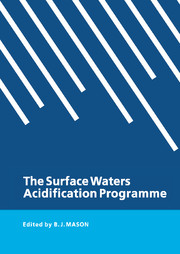Book contents
- Frontmatter
- Contents
- The rationale, design and management of the Surface Waters Acidification Programme
- I Hydrochemical studies in catchments
- II Catchment process studies
- III Catchment manipulation experiments
- IV Chemical processes
- V Palaeolimnological studies
- VI Effects of acidification on fish and other aquatic life
- VII Modelling studies
- VIII Discussion of conclusions
- Author index
- Subject index
The rationale, design and management of the Surface Waters Acidification Programme
Published online by Cambridge University Press: 05 February 2012
- Frontmatter
- Contents
- The rationale, design and management of the Surface Waters Acidification Programme
- I Hydrochemical studies in catchments
- II Catchment process studies
- III Catchment manipulation experiments
- IV Chemical processes
- V Palaeolimnological studies
- VI Effects of acidification on fish and other aquatic life
- VII Modelling studies
- VIII Discussion of conclusions
- Author index
- Subject index
Summary
Origin of the programme
The initial concept of the Surface Waters Acidification Programme (SWAP) was proposed by Sir Water Marshall (now Lord Marshall), Chairman of the Central Electricity Generating Board, in the Spring of 1983. At that time, the CEGB was being strongly criticized, especially in Norway and Sweden, on the grounds that the emissions of SO2 and NOx from its power stations were making a major contribution to the acidification of surface waters in southern Scandinavia. Following the researches done in Norway during 1972–80, the results of which were published in 1980 in a report entitled, Acid precipitation — effects on forest and fish, the CEGB had set in hand a major research programme of their own. Although the CEGB scientists became understandably rather defensive in the face of exaggerated statements that appeared in the media they, nevertheless, did a good deal of high-quality research and supported additional work in the universities. Even so, Marshall realized that however sound the work of his own organization might be, the results would be regarded with suspicion by its critics and he foresaw the need for a completely independent investigation, which he was willing to fund.
In March 1983 Marshall consulted me, as Treasurer of the Royal Society, as to whether the Society might be willing to coordinate and supervise a substantial five-year programme over which it would have full control, with no interference from the sponsor, once the objectives, scope and scale had been agreed.
- Type
- Chapter
- Information
- The Surface Waters Acidification Programme , pp. 1 - 8Publisher: Cambridge University PressPrint publication year: 1991

